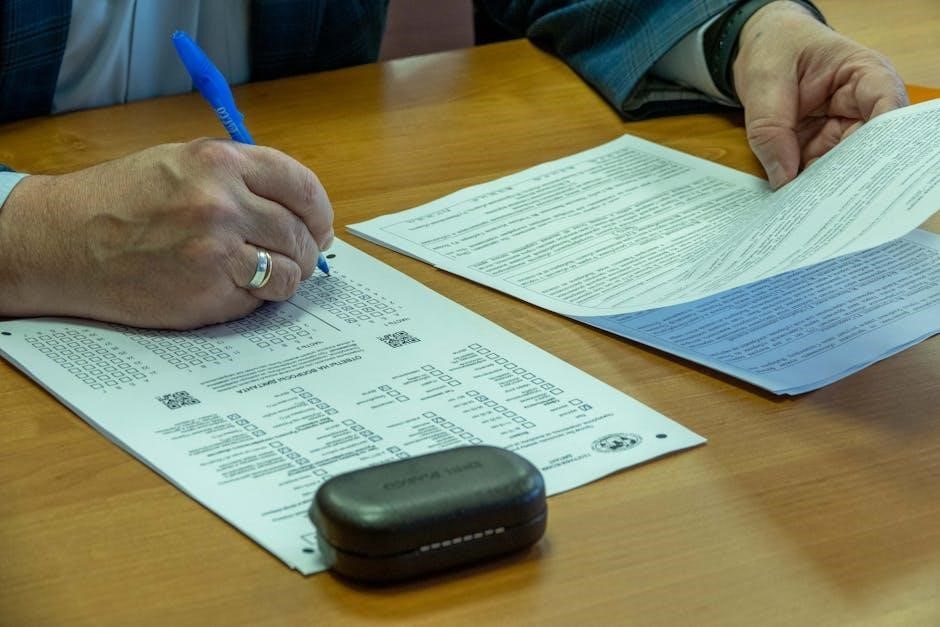A DOT inspection form is a standardized document ensuring commercial vehicles meet safety and compliance standards. It covers essential checks like brakes‚ tires‚ and lighting‚ preventing accidents and regulatory issues. Using DOT inspection form templates simplifies the process‚ ensuring accuracy and adherence to federal guidelines.
1.1 What is a DOT Inspection Form?
A DOT inspection form is a standardized document used to evaluate the safety and compliance of commercial vehicles. It includes detailed checks of critical components such as the brake system‚ tires‚ steering mechanism‚ and lighting systems. The form ensures vehicles meet strict DOT regulations‚ helping to prevent accidents and maintain road safety. Available as a PDF template‚ it offers customization options‚ allowing users to tailor it to specific needs while ensuring compliance with federal guidelines. The form typically includes sections for vehicle identification‚ inspection date‚ and certification‚ making it an essential tool for inspectors and technicians.
1.2 Importance of DOT Inspection Forms
DOT inspection forms are crucial for maintaining road safety and ensuring compliance with federal regulations. They help identify and address vehicle defects before they lead to accidents‚ protecting both drivers and other road users. By standardizing the inspection process‚ these forms reduce the risk of human error and ensure consistency across all vehicles. Additionally‚ they provide a documented record of inspections‚ which can be vital for audit purposes and liability protection. Regular use of DOT inspection form templates promotes a culture of safety and accountability within fleets‚ contributing to overall public safety and operational efficiency.
1.3 Purpose of the DOT Inspection Process
The primary purpose of the DOT inspection process is to ensure that commercial vehicles operate safely and in compliance with federal regulations. It aims to identify and address potential safety hazards before they lead to accidents. The process involves a thorough examination of vehicle components‚ such as brakes‚ tires‚ and lighting systems‚ to verify their proper functioning. By documenting inspection findings‚ the DOT inspection process promotes accountability and transparency‚ ensuring that vehicles meet the required safety standards. This systematic approach not only enhances road safety but also supports efficient fleet management and compliance with legal requirements. Regular inspections are essential for maintaining public trust and operational integrity.

Components of a DOT Inspection Form
A DOT inspection form includes sections for vehicle identification‚ inspection date‚ technician details‚ and a detailed vehicle history record. It also covers critical systems like brakes and tires for safety compliance.
2.1 Vehicle Identification Section
The Vehicle Identification Section is a critical part of the DOT inspection form‚ containing essential details about the vehicle. It typically includes the Vehicle Identification Number (VIN)‚ unit number‚ and vehicle type (e.g.‚ truck‚ bus‚ or tractor-trailer). This section also specifies the agency or location optional field and provides a vehicle history record. Accurate identification ensures proper documentation and traceability‚ making it vital for compliance with DOT regulations. The information here helps inspectors and organizations maintain detailed records‚ facilitating audits and ensuring adherence to safety standards. This section is fundamental for organizing and verifying the vehicle’s identity before proceeding with the inspection process.
2.2 Inspection Date and Location
The Inspection Date and Location section is vital for maintaining accurate records. It requires the date when the inspection was conducted and the specific location where the vehicle was examined. This information ensures traceability and accountability‚ making it easier to verify compliance with regulations. The date helps track inspection frequency‚ while the location provides context for environmental or operational conditions. Proper documentation here supports audits and demonstrates adherence to safety standards. Including inspector details adds an extra layer of accountability‚ ensuring that all checks are conducted by qualified personnel. This section is essential for maintaining a clear and transparent inspection history.
2.3 Inspector and Technician Information
The Inspector and Technician Information section ensures accountability by identifying who performed the inspection. It typically includes the inspector’s name‚ certification number‚ and facility or company details. This information verifies that the inspection was conducted by a qualified professional‚ adhering to DOT regulations. Including technician details also helps in tracking their performance and ensuring they meet required standards. Proper documentation here supports compliance audits and provides a clear audit trail. This section is crucial for maintaining transparency and trust in the inspection process‚ ensuring all parties involved are held to high standards of professionalism and expertise.
2.4 Vehicle History Record
The Vehicle History Record section captures the vehicle’s maintenance and inspection history. It includes details like the vehicle identification number (VIN)‚ fleet unit number‚ and previous inspection dates. This record helps track compliance with regular maintenance schedules and ensures that any recurring issues are addressed. By documenting past inspections and repairs‚ this section provides a comprehensive overview of the vehicle’s condition over time. It also aids in identifying potential patterns of wear or neglect‚ promoting proactive maintenance and enhancing safety. Accurate records here are essential for compliance with DOT regulations and maintaining operational integrity.
2;5 Brake System Inspection
The Brake System Inspection is a critical component of the DOT inspection form. It ensures the vehicle’s brakes are functioning properly to prevent accidents. Inspectors check service brakes‚ parking brakes‚ and the air brake system (if applicable). Key components include brake drums‚ rotors‚ brake pads‚ and brake linings; The inspection also verifies the condition of hoses‚ connections‚ and reservoirs. Any defects‚ such as excessive wear or leaks‚ must be documented and repaired. A failed brake system can lead to severe safety hazards and non-compliance with regulations. This section ensures the vehicle can stop safely and reliably‚ making it a cornerstone of the DOT inspection process. Proper documentation is essential for maintaining compliance and road safety.
2.6 Steering Mechanism Inspection
The Steering Mechanism Inspection evaluates the vehicle’s steering system for safety and functionality. Inspectors check the steering wheel free play‚ steering column‚ and linkage components. This ensures precise control and alignment. Any looseness‚ wear‚ or damage to tie rods‚ ball joints‚ or drag links is noted. The inspection also verifies the condition of power steering systems‚ if equipped. Defects in the steering mechanism can lead to loss of vehicle control‚ making this section vital for road safety. Proper documentation ensures compliance with DOT regulations and helps maintain safe vehicle operation. This inspection is a key part of the overall DOT form‚ ensuring driver control and vehicle stability. Regular checks prevent potential hazards and ensure reliable steering performance.
2.7 Suspension and Spring Inspection
The suspension and spring inspection ensures the vehicle’s structural integrity and ride stability. Inspectors examine leaf springs‚ coil springs‚ and shackles for wear or damage. The spring hangers‚ u-bolts‚ and torque arms are checked for proper tightness and condition. Any cracks‚ fractures‚ or excessive sagging in the suspension components is documented. This inspection is critical for maintaining vehicle stability and preventing potential failures‚ especially under heavy loads. Proper suspension function also affects braking efficiency and overall safety. The DOT inspection form includes detailed checks to ensure compliance and roadworthiness‚ making this section essential for safe vehicle operation and regulatory adherence. Regular inspections help prevent costly repairs and ensure safe transportation of goods and passengers.

2.8 Tire and Wheel Inspection
The tire and wheel inspection is a critical component of the DOT inspection process. Inspectors check for tire tread depth‚ ensuring it meets federal regulations to prevent skidding hazards. They look for signs of uneven wear‚ cuts‚ or bulges that could indicate internal damage. The wheel rims are examined for cracks or dents‚ and hubcaps must be securely in place. Proper tire inflation is verified to enhance safety and fuel efficiency. Additionally‚ lug nuts are checked for tightness and damage. Any defects in tires or wheels are documented to ensure repairs are made before the vehicle returns to service. This inspection is vital for maintaining vehicle stability and preventing accidents caused by tire failure.
2.9 Lighting and Electrical Systems
The lighting and electrical systems inspection ensures all vehicle lights and electrical components function properly. Inspectors check headlights‚ taillights‚ brake lights‚ turn signals‚ and emergency flashers for operation and visibility. They verify that reflective triangles and warning devices are present and accessible. The electrical system is evaluated for damaged wiring‚ loose connections‚ or short circuits. Properly functioning lighting ensures visibility and safety on the road‚ while a reliable electrical system prevents malfunctions. Defects in these areas must be noted and repaired to maintain compliance and prevent potential hazards. This inspection is critical for ensuring the vehicle’s visibility and operational safety.

Types of DOT Inspections
DOT inspections vary by type‚ including annual inspections‚ pre-trip‚ post-trip‚ and roadside inspections. Each ensures vehicle safety and compliance with federal regulations‚ targeting different stages of operation and maintenance.
3.1 Annual Vehicle Inspection
The Annual Vehicle Inspection is a comprehensive evaluation of a commercial vehicle’s safety and regulatory compliance. Conducted once a year‚ it covers critical systems such as brakes‚ steering‚ suspension‚ tires‚ and lighting. Inspectors must follow the guidelines set by 49 CFR Part 396 to ensure thoroughness. The inspection results are documented on a DOT inspection form‚ which includes a detailed report of all components checked. Vehicles that pass receive certification‚ while those with defects require repairs before returning to service. This annual check is vital for maintaining road safety and preventing potential hazards. Proper documentation is essential for compliance and accountability.
3.2 Pre-Trip Inspection
A pre-trip inspection is a critical routine check conducted by drivers before operating a commercial vehicle. It ensures the vehicle is safe for operation and compliant with regulations. Key components inspected include brakes‚ tires‚ lights‚ steering‚ and suspension. Drivers must verify that all essential systems are functioning properly. The findings are documented on a DOT inspection form‚ which serves as a record of the vehicle’s condition. This process helps prevent accidents‚ reduces maintenance issues‚ and ensures compliance with federal safety standards. Regular pre-trip inspections are a cornerstone of road safety and operational efficiency for commercial fleets. They are also a legal requirement in many jurisdictions.
3.3 Post-Trip Inspection
A post-trip inspection is conducted after a vehicle completes its journey to identify any issues that arose during operation. It involves checking critical systems like brakes‚ tires‚ suspension‚ and lighting to ensure they remain functional and safe. Drivers document findings on a DOT inspection form‚ noting defects or wear that require attention. This step is vital for maintaining vehicle reliability and preventing potential failures. Post-trip inspections also help in scheduling timely repairs and ensuring compliance with safety regulations. By systematically reviewing the vehicle‚ drivers contribute to overall fleet maintenance and safety standards‚ reducing the risk of future operational issues. Consistent post-trip checks are essential for long-term vehicle integrity.
3.4 Roadside Inspection
A roadside inspection is a spontaneous check conducted by law enforcement or safety officials to ensure a vehicle’s compliance with safety regulations. It typically occurs at designated inspection stations or during traffic stops. Inspectors review the vehicle’s condition‚ focusing on critical components such as brakes‚ tires‚ suspension‚ and lighting. Drivers must present documentation‚ including the DOT inspection form‚ to verify compliance. Any defects or violations identified during the inspection may result in penalties or the vehicle being placed out of service until repairs are made. Roadside inspections are a crucial enforcement tool for maintaining road safety and ensuring adherence to federal and state regulations.

Legal Requirements for DOT Inspections

Compliance with 49 CFR Part 396 is mandatory for commercial vehicles. Certification‚ documentation‚ and accurate record-keeping are essential for legal adherence‚ ensuring road safety and preventing accidents.
4.1 Compliance with 49 CFR Part 396
Compliance with 49 CFR Part 396 is critical for ensuring vehicle safety and regulatory adherence. This federal regulation outlines requirements for inspections‚ repairs‚ and maintenance of commercial vehicles. Companies must conduct annual inspections‚ document defects‚ and maintain detailed records. The DOT inspection form serves as a standardized tool to verify compliance. It ensures that all vehicle components‚ such as brakes‚ tires‚ and lighting systems‚ meet safety standards. Proper certification by qualified inspectors is mandatory. Failure to comply can result in penalties‚ fines‚ and operational disruptions. Adhering to these regulations helps prevent accidents and maintains public safety on the road.
4.2 Certification and Documentation
Certification and proper documentation are essential for maintaining compliance with DOT regulations. Inspectors must be certified and qualified to perform inspections‚ ensuring they meet federal standards. The DOT inspection form must include detailed records of all findings‚ repairs‚ and certifications. Documentation should be accurate‚ complete‚ and retained for a specified period. This ensures accountability and provides evidence of compliance during audits. Failure to maintain proper records can result in penalties and legal consequences. Certification verifies that the inspection was conducted thoroughly‚ while documentation serves as proof of adherence to safety protocols. Both are critical for operational integrity and legal compliance.
4.3 Record-Keeping Requirements
DOT regulations mandate specific record-keeping requirements for inspections. All inspection records must be maintained for at least one year and three months‚ ensuring traceability and compliance. These records must be readily accessible for review during audits or inspections. Proper documentation includes dates‚ inspection details‚ and corrective actions taken. Digital or physical storage systems must ensure accuracy and organization. Failure to maintain these records can result in severe penalties‚ fines‚ or operational shutdowns. Adhering to these requirements ensures accountability and demonstrates a commitment to safety and regulatory compliance‚ safeguarding both the company and public safety on the road. Accurate record-keeping is non-negotiable in the transportation industry.

How to Fill Out a DOT Inspection Form
Filling out a DOT inspection form requires accuracy and attention to detail. Start with vehicle identification and inspection date. Document all findings‚ noting defects and repairs. Ensure technician certification is included for compliance. Adhere to federal guidelines to avoid penalties and maintain safety standards. Proper completion ensures regulatory adherence and operational efficiency. Use clear‚ concise language throughout the form. Double-check all entries before finalizing. Accuracy is crucial for legal and safety purposes. Follow the step-by-step guide to ensure no section is overlooked. Compliance with 49 CFR Part 396 is essential. Maintain organized records for future reference and audits. Ensure all inspections are thorough and well-documented. This process guarantees safety and regulatory compliance. Always verify the form’s completion before submission. Proper documentation prevents potential legal issues. Ensure all repairs are noted and signed off. Accuracy in reporting is vital for maintaining trust and safety. Follow established protocols to ensure consistency. Regular training for inspectors is recommended. Use checklists to avoid missing critical components. Ensure all sections are legible and complete. Proper storage of completed forms is mandatory. Regular audits can help identify gaps in the process. Continuous improvement ensures ongoing compliance and safety. Always refer to the latest guidelines for updates. Understanding the process is key to effective inspections. Properly filled forms protect both the company and public safety. Ensure all requirements are met to avoid penalties. Accuracy and attention to detail are non-negotiable. Properly completed forms are essential for operational continuity. Always prioritize safety and compliance when filling out the form. Ensure all defects are addressed promptly. Proper documentation supports accountability. Regular reviews of completed forms help maintain quality. Ensure all entries are accurate and truthful. Proper completion of the form safeguards against legal risks. Always follow the established procedures for inspections. Ensure all necessary sections are filled out completely. Properly documented inspections ensure regulatory compliance. Accuracy is critical in every step of the process. Properly filled forms protect the company’s reputation. Ensure all inspections are conducted thoroughly and fairly; Proper documentation supports seamless audits and reviews. Always verify the form’s accuracy before submission. Proper completion ensures safety and compliance. Ensure all requirements are met to avoid penalties. Accuracy and attention to detail are non-negotiable. Properly filled forms are essential for operational continuity. Always prioritize safety and compliance when filling out the form. Ensure all defects are addressed promptly. Proper documentation supports accountability. Regular reviews of completed forms help maintain quality. Ensure all entries are accurate and truthful. Proper completion of the form safeguards against legal risks. Always follow the established procedures for inspections. Ensure all necessary sections are filled out completely. Properly documented inspections ensure regulatory compliance. Accuracy is critical in every step of the process. Properly filled forms protect the company’s reputation. Ensure all inspections are conducted thoroughly and fairly. Proper documentation supports seamless audits and reviews. Always verify the form’s accuracy before submission. Proper completion ensures safety and compliance. Ensure all requirements are met to avoid penalties. Accuracy and attention to detail are non-negotiable. Properly filled forms are essential for operational continuity. Always prioritize safety and compliance when filling out the form. Ensure all defects are addressed promptly. Proper documentation supports accountability. Regular reviews of completed forms help maintain quality. Ensure all entries are accurate and truthful. Proper completion of the form safeguards against legal risks. Always follow the established procedures for inspections. Ensure all necessary sections are filled out completely. Properly documented inspections ensure regulatory compliance. Accuracy is critical in every step of the process. Properly filled forms protect the company’s reputation. Ensure all inspections are conducted thoroughly and fairly. Proper documentation supports seamless audits and reviews. Always verify the form’s accuracy before submission. Proper completion ensures safety and compliance. Ensure all requirements are met to avoid penalties. Accuracy and attention to detail are non-negotiable. Properly filled forms are essential for operational continuity. Always prioritize safety and compliance when filling out the form. Ensure all defects are addressed promptly. Proper documentation supports accountability. Regular reviews of completed forms help maintain quality. Ensure all entries are accurate and truthful. Proper completion of the form safeguards against legal risks. Always follow the established procedures for inspections. Ensure all necessary sections are filled out completely. Properly documented inspections ensure regulatory compliance. Accuracy is critical in every step of the process. Properly filled forms protect the company’s reputation. Ensure all inspections are conducted thoroughly and fairly. Proper documentation supports seamless audits and reviews. Always verify the form’s accuracy before submission. Proper completion ensures safety and compliance. Ensure all requirements are met to avoid penalties. Accuracy and attention to detail are non-negotiable. Properly filled forms are essential for operational continuity. Always prioritize safety and compliance when filling out the form. Ensure all defects are addressed promptly. Proper documentation supports accountability. Regular reviews of completed forms help maintain quality. Ensure all entries are accurate and truthful. Proper completion of the form safeguards against legal risks. Always follow the established procedures for inspections. Ensure all necessary sections are filled out completely. Properly documented inspections ensure regulatory compliance. Accuracy is critical in every step of the process. Properly filled forms protect the company’s reputation. Ensure all inspections are conducted thoroughly and fairly. Proper documentation supports seamless audits and reviews. Always verify the form’s accuracy before submission. Proper completion ensures safety and compliance. Ensure all requirements are met to avoid penalties. Accuracy and attention to detail are non-negotiable. Properly filled forms are essential for operational continuity. Always prioritize safety and compliance when filling out the form. Ensure all defects are addressed promptly. Proper documentation supports accountability. Regular reviews of completed forms help maintain quality. Ensure all entries are accurate and truthful. Proper completion of the form safeguards against legal risks. Always follow the established procedures for inspections. Ensure all necessary sections are filled out completely. Properly documented inspections ensure regulatory compliance. Accuracy is critical in every step of the process. Properly filled forms protect the company’s reputation. Ensure all inspections are conducted thoroughly and fairly. Proper documentation supports seamless audits and reviews. Always verify the form’s accuracy before submission. Proper completion ensures safety and compliance. Ensure all requirements are met to avoid penalties. Accuracy and attention to detail are non-negotiable. Properly filled forms are essential for operational continuity. Always prioritize safety and compliance when filling out the form. Ensure all defects are addressed promptly. Proper documentation supports accountability. Regular reviews of completed forms help maintain quality. Ensure all entries are accurate and truthful. Proper completion of the form safeguards against legal risks. Always follow the established procedures for inspections. Ensure all necessary sections are filled out completely. Properly documented inspections ensure regulatory compliance. Accuracy is critical in every step of the process. Properly filled forms protect the company’s reputation. Ensure all inspections are conducted thoroughly and fairly. Proper documentation supports seamless audits and reviews. Always verify the form’s accuracy before submission. Proper completion ensures safety and compliance. Ensure all requirements are met to avoid penalties. Accuracy and attention to detail are non-negotiable. Properly filled forms are essential for operational continuity. Always prioritize safety and compliance when filling out the form. Ensure all defects are addressed promptly. Proper documentation supports accountability. Regular reviews of completed forms help maintain quality. Ensure all entries are accurate and truthful. Proper completion of the form safeguards against legal risks. Always follow the established procedures for inspections. Ensure all necessary sections are filled out completely. Properly documented inspections ensure regulatory compliance. Accuracy is critical in every step of the process. Properly filled forms protect the company’s reputation. Ensure all inspections are conducted thoroughly and fairly. Proper documentation supports seamless audits and reviews. Always verify the form’s accuracy before submission. Proper completion ensures safety and compliance. Ensure all requirements are met to avoid penalties. Accuracy and attention to detail are non-negotiable. Properly filled forms are essential for operational continuity. Always prioritize safety and compliance when filling out the form. Ensure all defects are addressed promptly. Proper documentation supports accountability. Regular reviews of completed forms help maintain quality. Ensure all entries are accurate and truthful. Proper completion of the form safeguards against legal risks. Always follow the established procedures for inspections. Ensure all necessary sections are filled out completely. Properly documented inspections ensure regulatory compliance. Accuracy is critical in every step of the process. Properly filled forms protect the company’s reputation. Ensure all inspections are conducted thoroughly and fairly. Proper documentation supports seamless audits and reviews. Always verify the form’s accuracy before submission. Proper completion ensures safety and compliance. Ensure all requirements are met to avoid penalties; Accuracy and attention to detail are non-negotiable. Properly filled forms are essential for operational continuity. Always prioritize safety and compliance when filling out the form. Ensure all defects are addressed promptly. Proper documentation supports accountability. Regular reviews of completed forms help maintain quality. Ensure all entries are accurate and truthful. Proper completion of the form safeguards against legal risks. Always follow the established procedures for inspections. Ensure all necessary sections are filled out completely. Properly documented inspections ensure regulatory compliance. Accuracy is critical in
5.1 Step-by-Step Guide to Completing the Form
Vehicle Identification: Start by entering the vehicle’s make‚ model‚ and VIN. Include the unit or fleet number for easy reference.
Inspection Date and Location: Record the date and location of the inspection for accuracy.
Inspector and Technician Information: Provide the inspector’s name‚ certification number‚ and facility details.
Vehicle History Record: Note the vehicle’s maintenance history and any previous issues.
Brake and Tire Inspection: Check and document the condition of brakes‚ tires‚ and wheels.
Additional Systems: Inspect steering‚ suspension‚ and lighting systems‚ noting any defects.
Defects and Repairs: List any deficiencies found and indicate if repairs were made.
Certification: Sign and date the form‚ confirming the vehicle meets DOT standards. Use a checklist to ensure no section is missed. Proper completion ensures compliance with 49 CFR Part 396.
5.2 Common Mistakes to Avoid
Incomplete Sections: Ensure all fields‚ such as vehicle identification and inspector details‚ are filled out. Missing information can lead to form rejection.
Missed Certification: Always include the technician’s certification number and signature‚ as required by 49 CFR Part 396.
Unsigned Forms: Forget to sign or date the form‚ rendering it invalid. Double-check for completeness before submission.
Illegible Handwriting: Use clear‚ legible writing to avoid misunderstandings. Consider using digital tools for better readability.
Missing Dates or VIN: Ensure the inspection date and vehicle identification number are accurate and present.
Overlooking Defects: Fail to document defects or repairs‚ which can lead to non-compliance issues. Always review the form thoroughly. Neglecting these steps can result in fines or operational delays.
5.3 Significance of Technician Certification
Technician certification is crucial for ensuring inspections meet DOT standards. Certified technicians have the necessary training and expertise to accurately assess vehicle safety‚ reducing the risk of oversight. Their certification ensures compliance with 49 CFR Part 396‚ validating the inspection process. Proper certification also builds trust in the inspection’s credibility‚ protecting both the company and technician from liability. Always verify a technician’s certification before allowing them to perform inspections‚ as uncertified individuals may lead to non-compliance. This step ensures inspections are thorough and meet all legal and safety requirements‚ maintaining road safety and regulatory adherence. Certification is non-negotiable for reliable and lawful inspections.

Benefits of Using DOT Inspection Form Templates
Using DOT inspection form templates ensures compliance‚ saves time‚ and improves accuracy. They offer customization options‚ streamline the inspection process‚ and enhance overall efficiency significantly.

6.1 Customization Options
DOT inspection form templates offer extensive customization to suit specific needs. Users can tailor sections for different vehicle types‚ such as trucks‚ buses‚ or trailers‚ ensuring relevance. Companies can add their branding‚ logos‚ and unique inspection criteria. Customizable fields allow for the inclusion of specific components like brake systems or lighting checks. Additionally‚ templates can be modified to align with company policies or industry-specific requirements. This flexibility ensures that each inspection form is comprehensive and tailored to the organization’s operational needs‚ enhancing both efficiency and compliance with regulatory standards.
6.2 Time-Saving Features
DOT inspection form templates are designed to streamline the inspection process‚ saving valuable time. Pre-designed forms eliminate the need to create documents from scratch‚ while digital tools allow for quick filling and signing. Features like fillable fields‚ auto-save‚ and reusable templates reduce administrative burdens. Many templates also include checklists and dropdown menus‚ enabling faster data entry. Additionally‚ the ability to access and complete forms on any device ensures inspections can be conducted efficiently‚ even on the go. These time-saving features help organizations maintain compliance without sacrificing productivity‚ making the inspection process more efficient and less labor-intensive.
6.3 Improved Accuracy and Compliance
Using DOT inspection form templates enhances accuracy and ensures compliance with federal regulations. These templates are designed to meet the strict standards outlined in 49 CFR Part 396‚ reducing the risk of errors. Predefined fields and checkboxes guide inspectors through the process‚ ensuring no critical components are overlooked. Digital templates often include validation features‚ which alert users to incomplete or incorrect entries. By adhering to a structured format‚ organizations can maintain consistent and precise records. This not only improves compliance but also reduces the likelihood of fines and penalties associated with incomplete or inaccurate inspections‚ ensuring safer vehicles on the road.

Best Practices for Conducting DOT Inspections
Conducting DOT inspections requires using detailed checklists to ensure thoroughness. Always inspect critical components like brakes and steering. Proper documentation is essential for compliance.